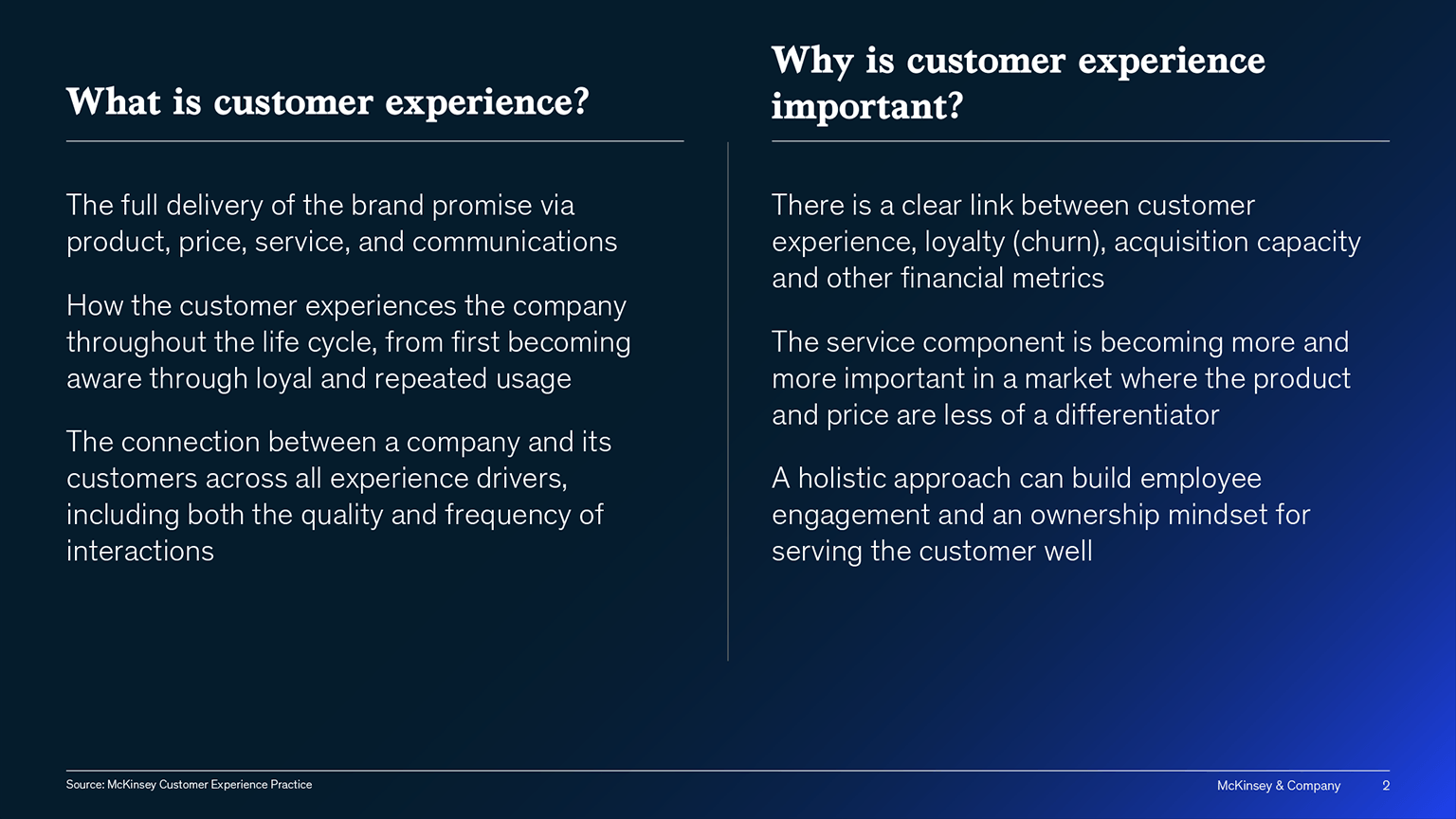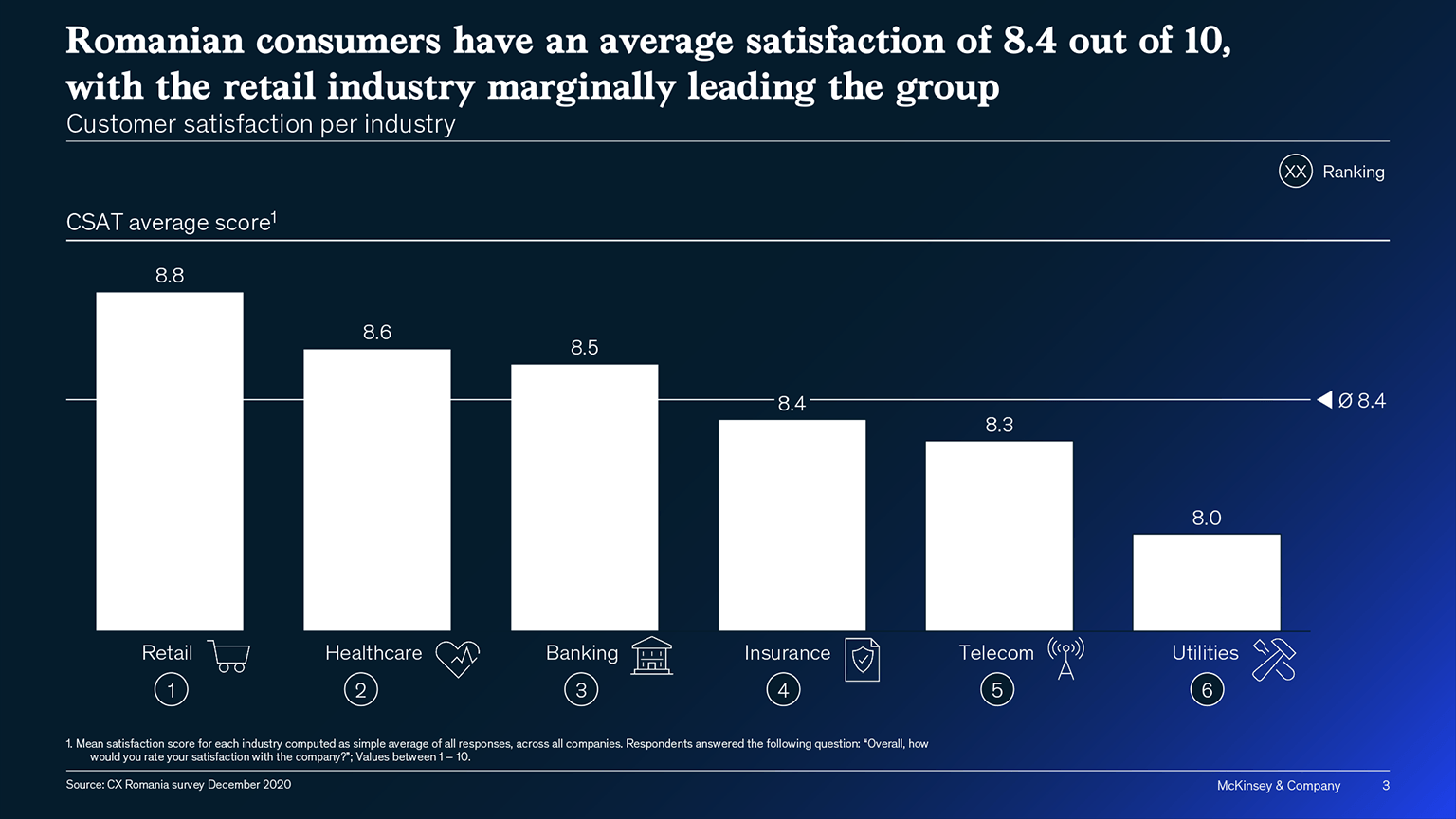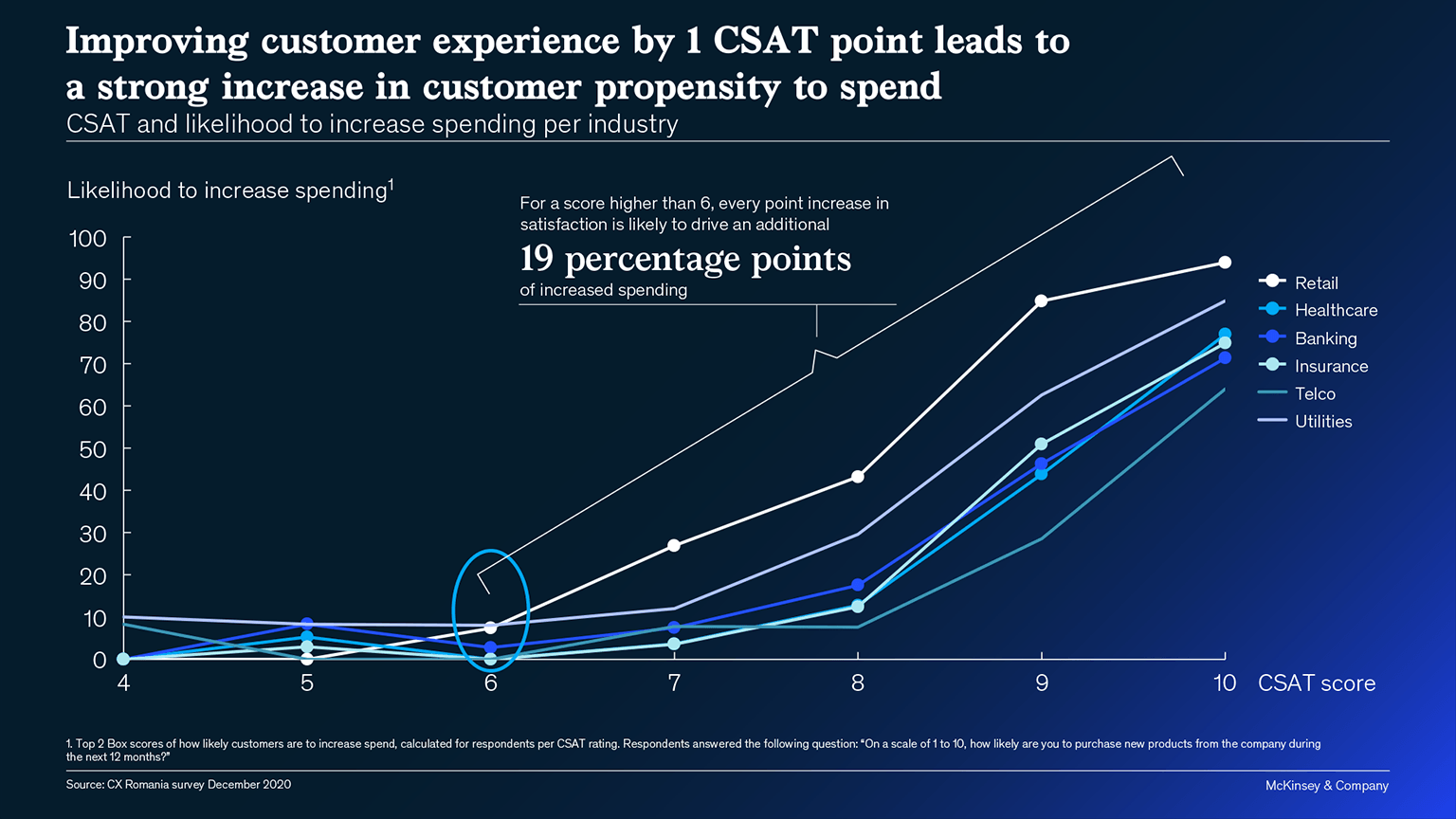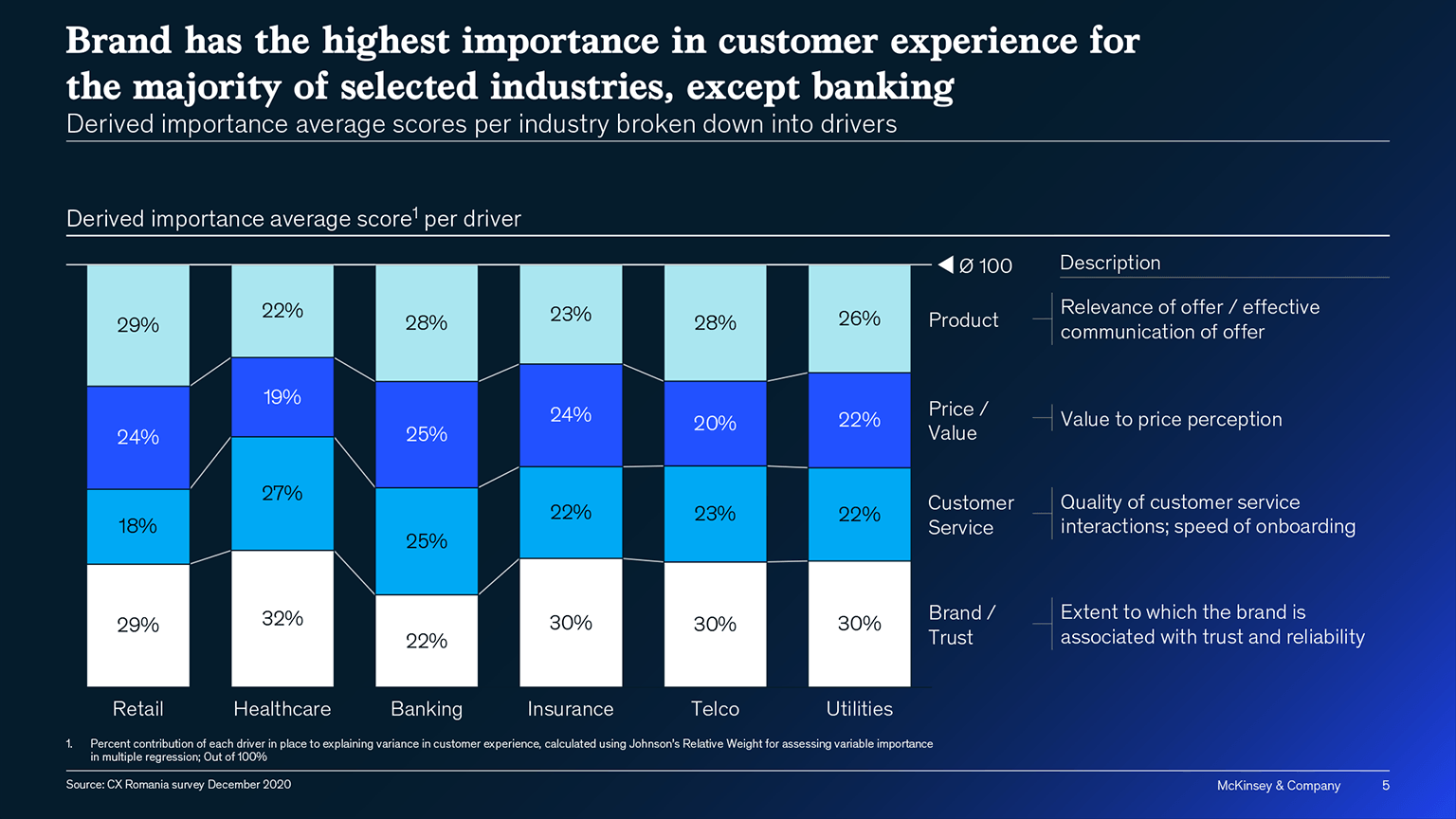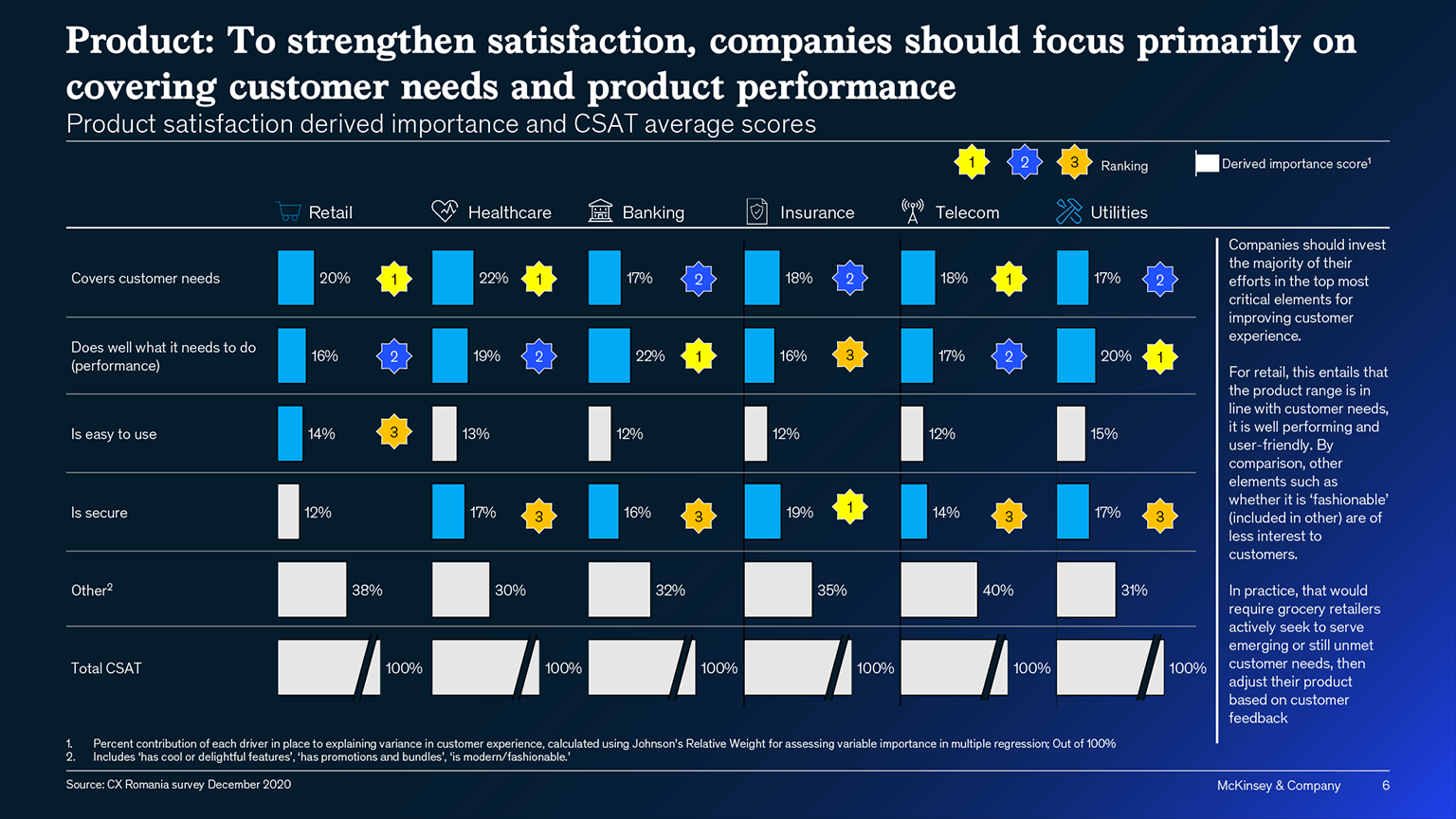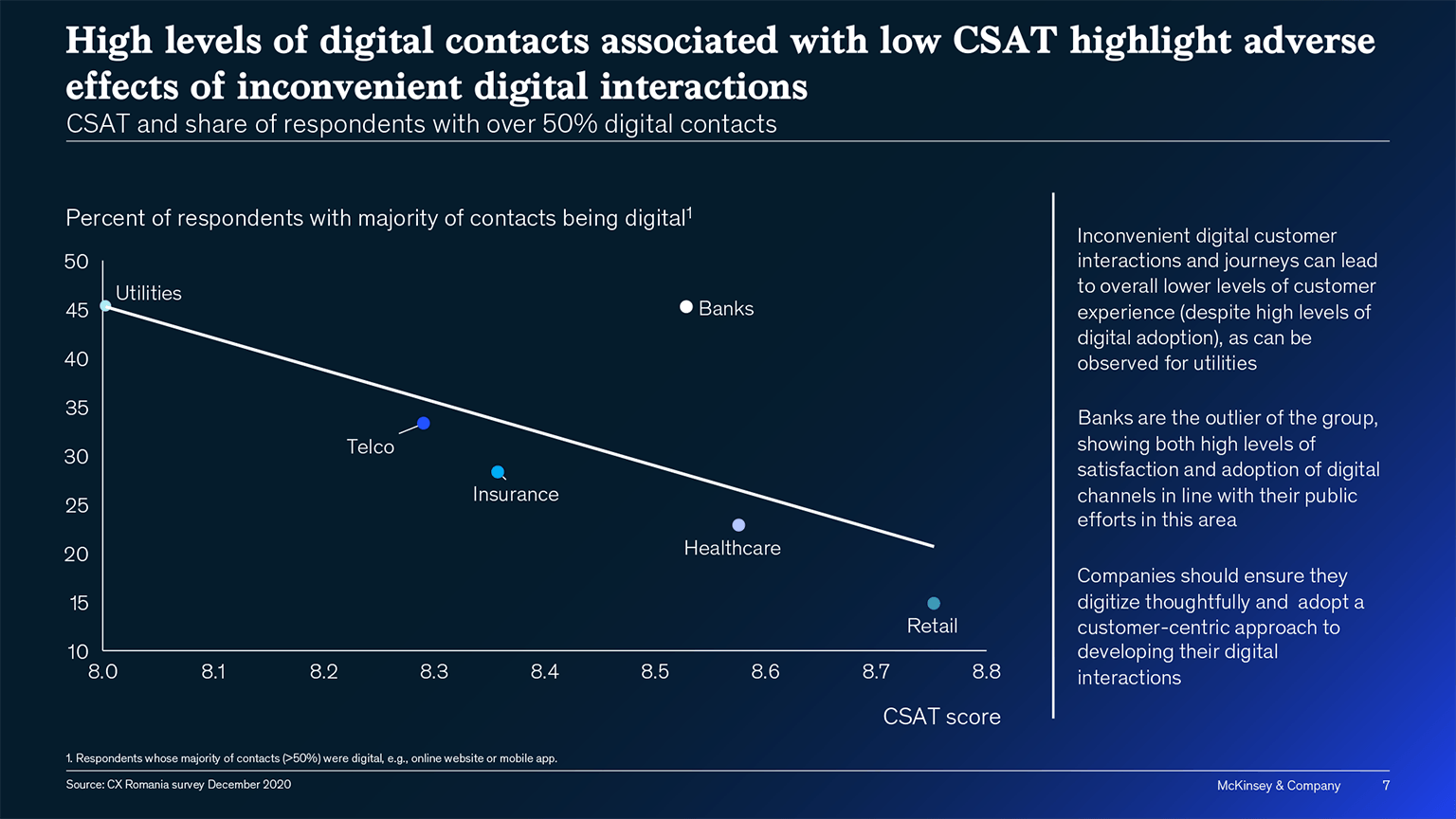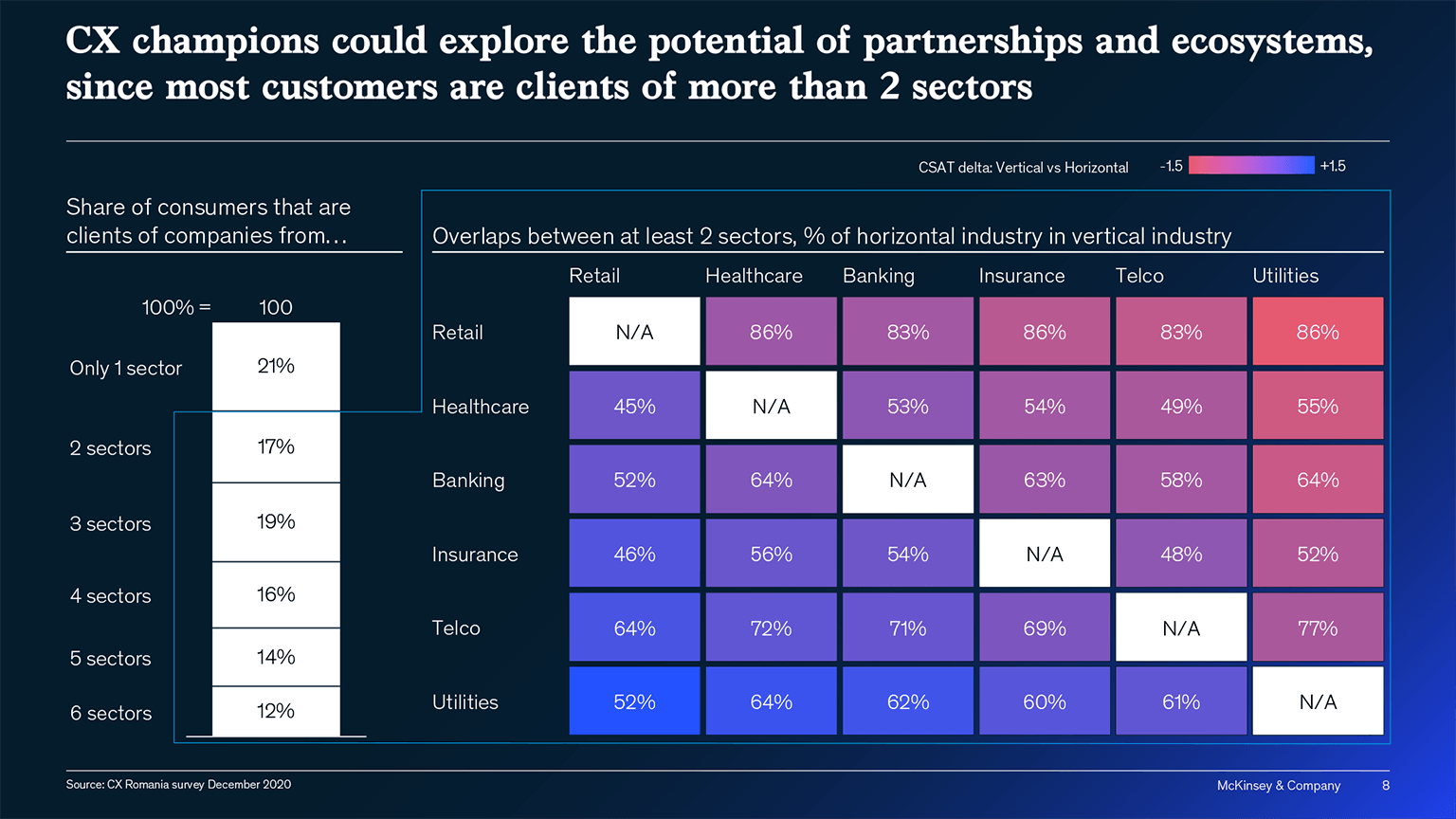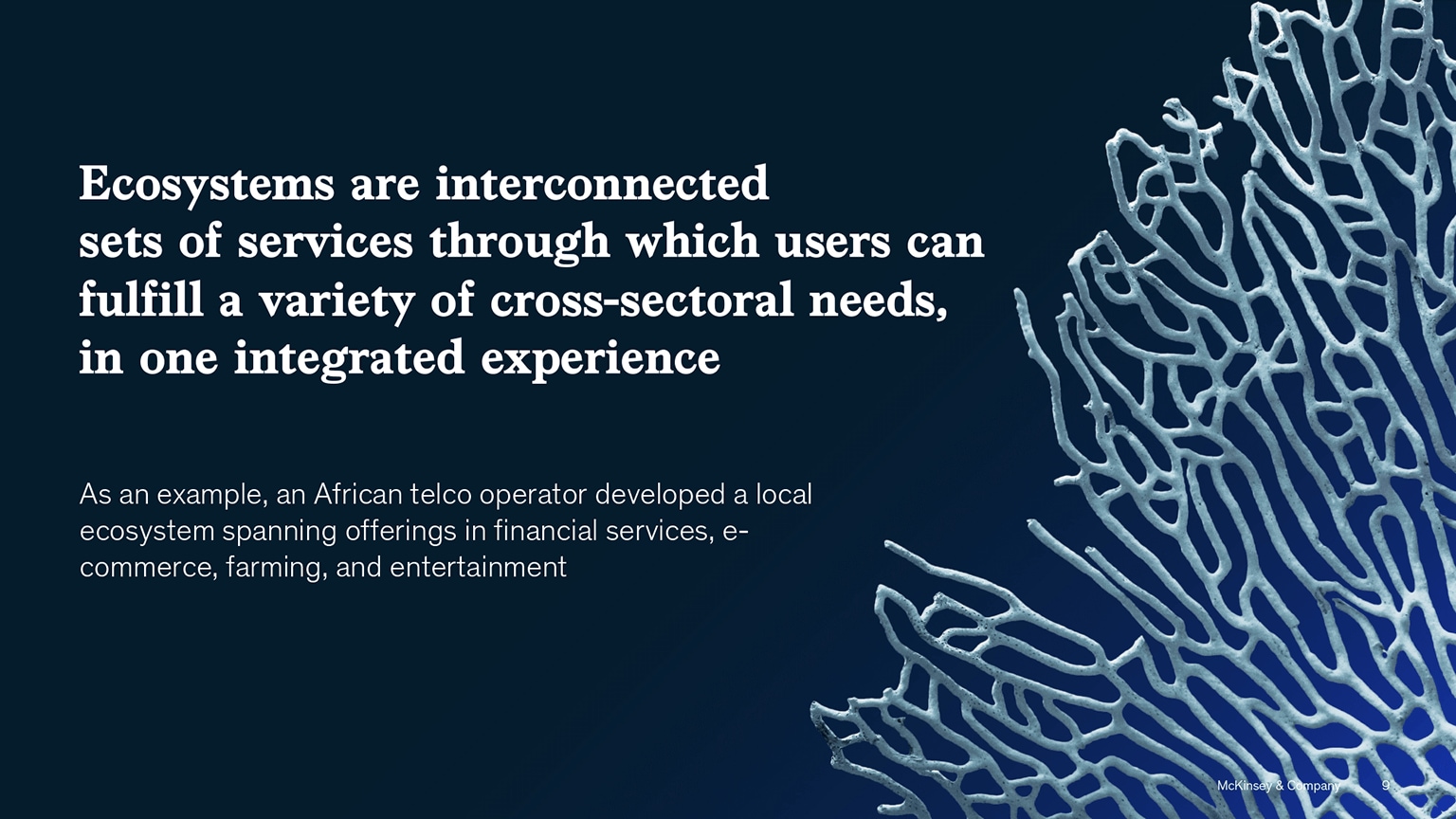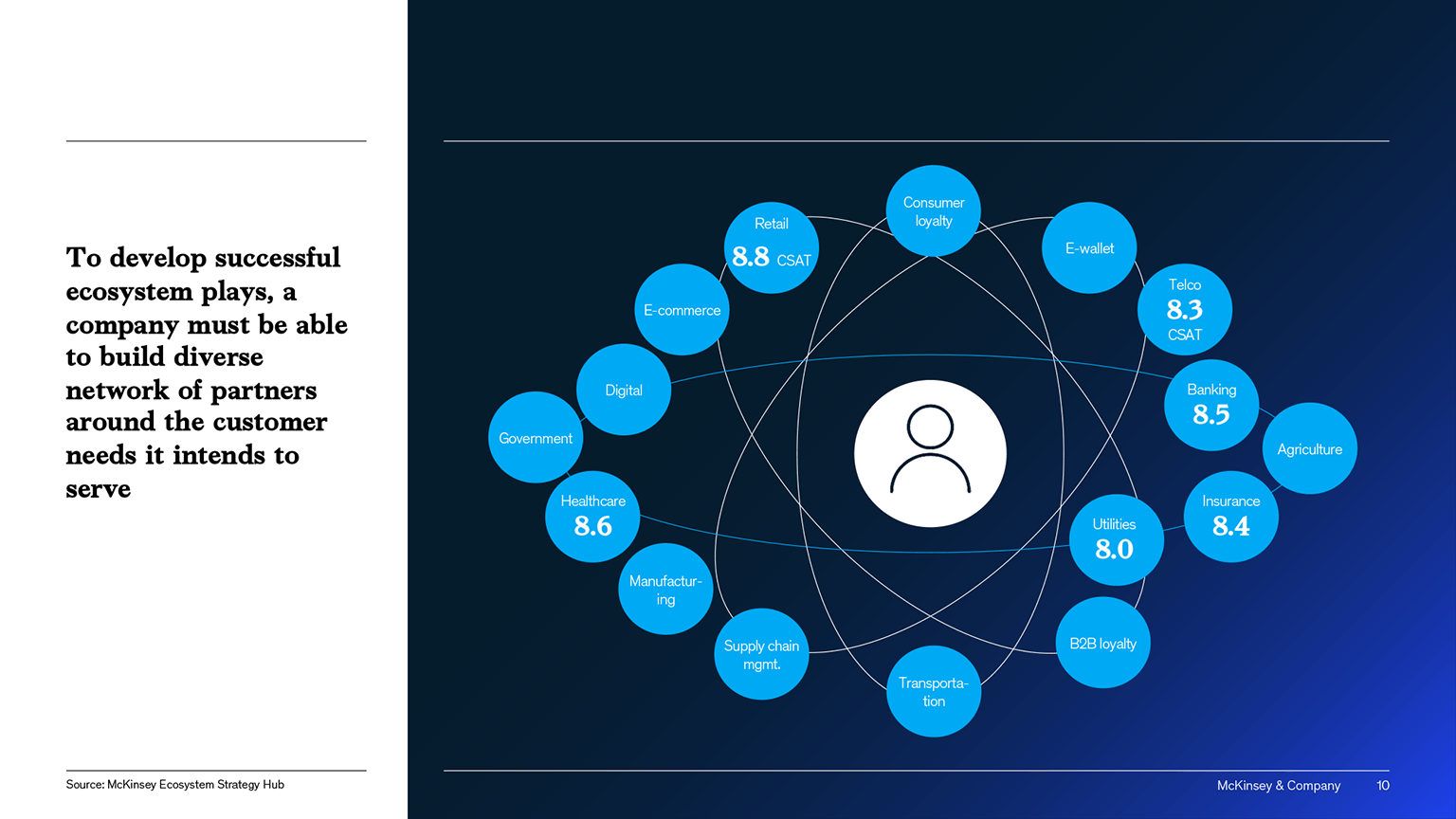Launched last December, the McKinsey Customer Experience Romania Survey is a comprehensive annual survey looking at the experience of Romanian customers across six industries: grocery retail, telecommunications, utilities, banking, insurance and healthcare. Approximately 2,000 respondents were asked to rate their customer satisfaction score (CSAT) on a scale from one to ten for each of the companies they use in the different industries. The results? Retail was rated best, with a CSAT score of 8.8, while utilities came bottom, with 8.0. Within each industry, companies' CSAT scores varied by at most ten percent, suggesting that Romanian consumers do not perceive any one company as standing out from the crowd in terms of customer experience.
What is customer experience, and why does it matter?
Customer experience can be understood as the full delivery of a company's brand promise via its products, price, service and communication. Superior customer experience enables deep customer trust and loyalty, while also having a positive impact on costs (for example, a 20-50 percent decrease in service costs by lowering the volume of complaints), revenues (a 15-20 percent increase in sales conversion) and customer satisfaction (a 10-20 percentage increase)1. Superior customer experience has also been shown to help companies deal with past financial crises: Customer experience champions suffer less and recover faster than customer experience underperformers2.
The McKinsey survey of Romanian consumers confirms many of these previous findings. It identifies a clear link between customer experience and willingness to spend: Improving customer experience by just one CSAT point leads to an approximately 20 percentage point increase in customers' propensity to spend. It also shows that market share and customer experience are closely correlated, with top-quartile companies by market share also displaying the highest CSAT scores. Clearly, an opportunity exists for Romanian companies to differentiate themselves from their peers through the customer experience they offer, and making improvements in this area should be a top priority for Romanian business leaders.
What can ambitious leaders do to improve customer experience?
Romanian companies that aspire to lead their industries can make improvements in two areas:
1. Focus on what matters
The survey analyzed the contribution of four different customer experience drivers − brand, price, customer service and product. Brand emerged as the most important contributor in all industries except for banking (where product and price are more important) and retail (product).
For each of the four drivers, their contributing elements were ranked in terms of their importance to customers. Romanian companies may wish to develop targeted actions that address each of these high-impact elements specifically for their industry. For instance, to improve product, banks could work on ensuring that their products meet all customer needs, while insurance companies could ensure their products are perceived as secure and reliable. For banks, that might translate into spending more time with customers trying to understand whether their products really meet their needs; insurance companies might want to highlight the extent and benefits of their coverage in their communication with consumers. Similarly, to improve customer service, healthcare and insurance companies could invest in redefining their onboarding journeys, while telecommunications companies could ensure that services for everyday use (such as checking balances) are in line with customer expectations. This might involve mapping out each customer journey step-by-step and testing new features with customers.
2. Digitize thoughtfully
The survey found that, with the notable exception of banks, higher levels of digital engagement have not resulted in improved customer experience in Romania. For instance, interactions with customers in retail are still predominantly non-digital, yet the industry has a high CSAT score (8.8), whereas the reverse is true for utilities (8.0). This trend is likely driven by rudimentary and non-customer-centric digitization, where cumbersome, mandatory digital interactions are more likely to decrease than to increase customer satisfaction. This finding also highlights the importance of a thoughtful, integrated approach to digitizing customer experience, such as a consistent omnichannel approach.
This recommendation is particularly relevant as the survey identified distinct preferences among Romanian consumers, such as the ability to switch smoothly between different channels (online vs. in person) depending on the customer journey. Thus, in-person interactions are preferred for resolving issues, whereas online is preferred for everyday use. Preferences also differ by customer age group: Younger consumers are less satisfied on average than older ones, with the largest gaps in insurance (a CSAT score of 7.9 vs. 8.7) and telecommunications (8.0 vs. 8.6). This may also be an area where companies would wish to make targeted improvements in their offerings or services.
Tailoring customer experiences to reflect their preferences regarding interaction type and preferred channels should move up on the agenda of Romanian companies. Progress could be achieved, for instance, by improving customer relationship management (CRM) capabilities and developing micro-campaigns tailored to different customer groups. An earlier McKinsey study found that when a one-size-fits-all sales approach is replaced by offers tailored to individual customer profiles, it can generate up to a 30-percent revenue increase3.
A new horizon of opportunity?
For companies striving to achieve excellence in customer experience, a new horizon of opportunity is emerging: partnerships and ecosystems. The survey confirms that around 80 percent of customers in Romania are clients of two or more industries, with the overlap ranging from more than 75 percent (between retail and banking, or telecommunications and utilities, say) to less than 50 percent (between healthcare and telecommunications).
Ecosystems are interconnected sets of services through which users can fulfill a variety of cross-sector needs in one integrated experience. It requires companies to move from individual offerings to integrated cross-sector offerings. For instance, one African telecommunications operator has developed a local ecosystem spanning financial services, e-commerce, farming and entertainment. Similarly, in Romania, banks could further monetize and increase their client base (while at the same time improving customer experience) by selling a broad range of standalone insurance products, while retailers could sell utility contracts and insurance companies could sell healthcare subscriptions. To do so effectively, however, Romanian companies would need to achieve a level of customer experience and intimacy that would allow them to extend the trust of their customers to their potential partners.
Next steps
The Romanian economy is expected to undergo significant changes in the next years, with the industries studied in the survey at the forefront of this transformation. Banks and insurance companies would be well advised to focus, among other things, on improving customer loyalty and increasing the adoption of financial products. Telecommunications companies could look at how to best use new technology, such as 5G, to serve emerging or unmet customer needs. Retailers can respond to the growth of digital channels, while utilities will want to address the recent market liberalization, and healthcare providers may want to address the growing needs of an aging population and the limitations of the public system. Across these industries, customer experience will be a crucial and much needed axis for growth – and an area where clear leaders have yet to emerge. The pursuit of better customer experience should have a positive impact not only on individual companies' commercial success, but also on the overall wellbeing and living standards of Romanian consumers.
About
The McKinsey Customer Experience Romania Survey is an annual survey that checks the pulse of the Romanian market, tracking the evolution of customer experience and delivering actionable insights for local companies.
